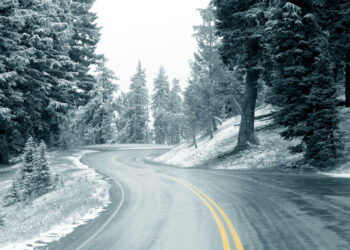CENTER FOR LARGE LANDSCAPE CONSERVATION
As the crisp air of autumn sweeps across the Gallatin Valley landscape, a timeless ritual begins to unfold: the fall migration of thousands of elk across the Greater Yellowstone Ecosystem. Each fall, herds move from higher-elevation summer ranges in Yellowstone National Park and surrounding areas to lower-elevation valleys, driven by food availability and the need to escape harsh winter conditions. They traverse vast distances—sometimes up to 60 or 70 miles—through the Gallatin and Madison ranges along routes followed for at least centuries, and probably much longer. Even resident herds are on the move this time of year, spurred by mating, the presence of hunters and more.
“The connections within and between high elevation areas and surrounding valleys are critical for regional elk,” said wildlife biologist Julie Cunningham of Montana Fish, Wildlife and Parks. “Maintaining landscape connections is important for the long-term conservation of elk populations.”
Seasonal migration and movement are not only iconic Montana events but also vital ecological processes. As elk move, they play a role in shaping plant communities by grazing and dispersing seeds. Further, their movement influences predators like wolves and bears, which rely on them as a food source. In these ways, elk movement helps to sustain local ecosystems.

As cities and towns expand into traditional elk habitats, it becomes harder for animals to maintain movement patterns. Today, rapid development in the Northern Rockies, including housing subdivisions, roads and fences, is fragmenting the landscape. Increased traffic poses a particular danger, with high-volume roads serving as physical barriers and leading to more collisions, killing elk and sometimes people, too. Fences further disrupt movement, trapping elk or forcing alternate and often more perilous routes.
One of the most visible herds in the Gallatin Valley spends time south of Gallatin Gateway. While the herd is being studied to learn about its movement patterns, expanding human activity serves to increase the challenge of accessing habitat patches.
“The south Bozeman elk herd is valued by the general public who would like to see this herd be able to safely use its remaining habitat,” said Cunningham.
Conservation organizations work to protect connections between habitat areas through activities such as securing conservation easements, conserving wildlife corridors, promoting wildlife-friendly fencing, and supporting the building of wildlife crossings along roads. One such organization is the Bozeman-based, nonprofit Center for Large Landscape Conservation, which works to ensure that wildlife can move freely across large landscapes.
“More traffic on roads means they can become a true barrier for wildlife, keeping them from accessing habitat,” said CLLC Road Ecologist Liz Fairbank, lead author of a study of wildlife and transportation on U.S. Highway 191 and Highway 64 from Four Corners to West Yellowstone.
With the involvement of public agencies such as FWP and the Montana Department of Transportation, CLLC and Montana State University’s Western Transportation Institute identified 11 priority sites along the two roads where wildlife crossings can reduce wildlife-vehicle collisions and reconnect habitat. This past September, MDT applied for a federal grant for a $26-million wildlife crossing project to enable wildlife to pass safely over and beneath US-191 south of Gallatin Gateway. The organization and community partners helped to move the project from concept to proposal through an engineering feasibility study and pledges to cover required, non-federal matching funds.
“We really need collaborative conservation,” said Fairbank. “Solutions for wildlife and people become possible when communities, agencies, and nonprofits work together.”
Fall elk migration and movement are key ecological processes that connect landscapes and sustain wildlife populations across the Greater Yellowstone Ecosystem. Maintaining ecological connectivity for wildlife is one way to ensure that iconic elk and other species can continue to thrive in the face of growing challenges, preserving the wildlife heritage of this remarkable landscape for generations to come.













